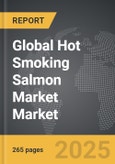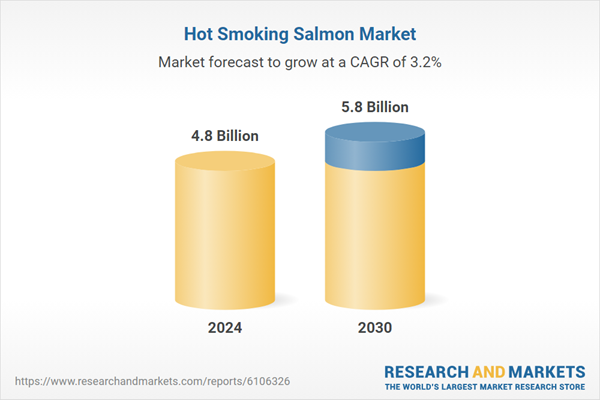Global Hot Smoking Salmon Market - Key Trends & Drivers Summarized
How Is Culinary Innovation Shaping the Hot Smoking Salmon Segment?
Culinary trends around the world are increasingly spotlighting hot smoking salmon as both a gourmet delicacy and a versatile protein option, driving its popularity among chefs, home cooks, and health-conscious consumers. Unlike cold smoked varieties, hot smoking cooks the fish during the smoking process, resulting in a tender, flaky texture and robust, smoky flavor that appeals to a wide range of palates. As global cuisine continues to embrace fusion and experimentation, hot smoking salmon is being infused with diverse marinades and rubs using ingredients like maple syrup, miso, chili, and citrus to create unique regional profiles. Foodservice establishments, including high-end restaurants, cafes, and even food trucks, are showcasing smoked salmon in innovative formats such as flatbreads, gourmet sandwiches, sushi rolls, and breakfast bowls. The increasing presence of smoked salmon in ready-to-eat and pre-packaged meal kits is further expanding its reach among time-pressed consumers who value convenience without sacrificing quality. Artisanal producers are differentiating their offerings with handcrafted techniques and small-batch production, using wood varieties like hickory, alder, and applewood to influence flavor depth. Additionally, there is rising interest in sustainably sourced and locally smoked salmon, with brands highlighting traceability and environmentally responsible practices as a selling point. As a result, hot smoking salmon is no longer confined to traditional seafood counters but is becoming a prominent feature in gourmet retail, meal delivery platforms, and high-end catering services. This culinary diversification is giving the category new momentum and transforming consumer perception of smoked fish from a niche indulgence into a lifestyle choice.Why Is Health-Conscious Eating Driving Increased Demand for Hot Smoking Salmon?
The growing focus on healthy lifestyles and balanced nutrition is significantly influencing the rising demand for hot smoking salmon, positioning it as a premium source of lean protein, essential fatty acids, and key micronutrients. As more consumers seek alternatives to red meat and processed foods, smoked salmon has emerged as a desirable option that aligns with clean eating principles while still delivering on flavor. Hot smoked salmon in particular is perceived as less processed than cured or cold smoked varieties, owing to its cooking process which does not require heavy salting or prolonged curing. It is rich in omega-3 fatty acids, known for supporting heart and brain health, as well as providing a range of vitamins such as B12 and D. This nutritional profile makes it a favorite among fitness enthusiasts, wellness-focused individuals, and people managing dietary conditions such as diabetes and high cholesterol. With an increasing number of consumers reading food labels and scrutinizing ingredient lists, manufacturers are focusing on transparency and clean labeling, offering products free from artificial preservatives, colorants, and additives. Portion-controlled packaging formats and snack-sized servings are also gaining popularity, making it easier for health-conscious buyers to integrate smoked salmon into daily meals or as a protein-rich snack. Retailers and brands are positioning hot smoking salmon in health food sections, often alongside items like quinoa, greens, and avocados, reinforcing its image as a smart dietary choice. As public awareness about the link between food and long-term wellness continues to grow, hot smoked salmon is being embraced not just as a flavorful dish, but as a functional food that delivers meaningful health benefits.How Are Processing Techniques and Sustainability Goals Shaping the Industry?
The production of hot smoking salmon is undergoing important changes as both processors and consumers demand improvements in product quality, environmental sustainability, and production transparency. Traditional smoking methods are being modernized through the use of automated temperature and humidity controls, which ensure consistency in texture and flavor while also meeting strict food safety standards. At the same time, artisanal producers continue to thrive by emphasizing craftsmanship, with hand-seasoning and slow-smoking techniques that yield distinctive, high-quality results. Sustainability has become a major priority in this space, with producers increasingly turning to certified aquaculture and responsible wild-capture sources that minimize the environmental impact of salmon farming. Many brands are now featuring certifications such as ASC, MSC, and organic labeling to assure consumers of their sustainable practices. Packaging is also evolving, with innovations focused on reducing plastic use and increasing recyclability, including vacuum-sealed compostable films and paper-based trays. Water and energy conservation in smoking facilities is another area of focus, with companies investing in energy-efficient smokers and cleaner wood-burning technologies. Traceability from catch to shelf is being implemented through blockchain systems and QR codes that allow consumers to verify the origin and journey of their fish. These practices are not only helping businesses meet environmental goals but are also responding to consumer expectations for ethical and sustainable products. As environmental awareness becomes a more central aspect of consumer behavior, companies that prioritize clean processing and transparent supply chains are expected to gain greater loyalty and market share in the years ahead.What Factors Are Fueling the Growth of the Hot Smoking Salmon Market Globally?
The growth in the hot smoking salmon market is driven by several interlinked factors rooted in evolving consumer behavior, culinary expansion, and retail innovation. A primary driver is the growing global appetite for protein-rich foods that align with wellness goals, with hot smoked salmon standing out as both nutrient-dense and convenient. The expansion of international cuisine into mainstream dining has also played a role, as consumers discover and adopt smoked salmon through diverse formats like bagels, poke bowls, and tapas. Convenience is another major factor, as modern shoppers gravitate toward ready-to-eat foods that require little to no preparation but still deliver high quality and gourmet appeal. This demand has encouraged retailers to expand their refrigerated offerings and create innovative packaging that extends shelf life without compromising freshness. The rise of e-commerce and direct-to-consumer seafood delivery platforms has also made it easier for specialty and premium smoked salmon brands to reach a global audience. Additionally, increasing disposable incomes and changing food preferences in developing markets are contributing to demand, especially in urban areas where consumers are exploring upscale and international flavors. Hotels, airlines, and catering services are also incorporating hot smoked salmon into their premium meal offerings, further driving volume and visibility. Government regulations encouraging healthier diets and lower red meat consumption are indirectly supporting growth, as consumers seek more sustainable and heart-healthy options. Overall, a combination of culinary sophistication, convenience, health awareness, and improved distribution models is creating fertile ground for the continued expansion of the hot smoking salmon market worldwide.Report Scope
The report analyzes the Hot Smoking Salmon market, presented in terms of market value (US$). The analysis covers the key segments and geographic regions outlined below:- Segments: Distribution Channel (Offline Distribution Channel, Online Distribution Channel); End-Use (Food Services End-Use, Retail End-Use).
- Geographic Regions/Countries: World; United States; Canada; Japan; China; Europe (France; Germany; Italy; United Kingdom; Spain; Russia; and Rest of Europe); Asia-Pacific (Australia; India; South Korea; and Rest of Asia-Pacific); Latin America (Argentina; Brazil; Mexico; and Rest of Latin America); Middle East (Iran; Israel; Saudi Arabia; United Arab Emirates; and Rest of Middle East); and Africa.
Key Insights:
- Market Growth: Understand the significant growth trajectory of the Offline Distribution Channel segment, which is expected to reach US$3.8 Billion by 2030 with a CAGR of a 2.6%. The Online Distribution Channel segment is also set to grow at 4.4% CAGR over the analysis period.
- Regional Analysis: Gain insights into the U.S. market, valued at $1.3 Billion in 2024, and China, forecasted to grow at an impressive 5.8% CAGR to reach $1.1 Billion by 2030. Discover growth trends in other key regions, including Japan, Canada, Germany, and the Asia-Pacific.
Why You Should Buy This Report:
- Detailed Market Analysis: Access a thorough analysis of the Global Hot Smoking Salmon Market, covering all major geographic regions and market segments.
- Competitive Insights: Get an overview of the competitive landscape, including the market presence of major players across different geographies.
- Future Trends and Drivers: Understand the key trends and drivers shaping the future of the Global Hot Smoking Salmon Market.
- Actionable Insights: Benefit from actionable insights that can help you identify new revenue opportunities and make strategic business decisions.
Key Questions Answered:
- How is the Global Hot Smoking Salmon Market expected to evolve by 2030?
- What are the main drivers and restraints affecting the market?
- Which market segments will grow the most over the forecast period?
- How will market shares for different regions and segments change by 2030?
- Who are the leading players in the market, and what are their prospects?
Report Features:
- Comprehensive Market Data: Independent analysis of annual sales and market forecasts in US$ Million from 2024 to 2030.
- In-Depth Regional Analysis: Detailed insights into key markets, including the U.S., China, Japan, Canada, Europe, Asia-Pacific, Latin America, Middle East, and Africa.
- Company Profiles: Coverage of players such as AdvancedMD, Allscripts (Veradigm), Cerner (Oracle Health), CompuGroup Medical, CPSI (Evident) and more.
- Complimentary Updates: Receive free report updates for one year to keep you informed of the latest market developments.
Some of the 34 companies featured in this Hot Smoking Salmon market report include:
- Acme Smoked Fish Corp.
- Alaska Smokehouse
- Banner Smoked Fish, Inc.
- Blue Hill Bay (Acme Brand)
- Ducktrap River of Maine
- Farne Salmon & Trout Ltd
- Foppen Seafood
- Gottfried Friedrichs KG
- Grieg Seafood ASA
- HanseGarnelen GmbH & Co. KG
- H. Forman & Son
- JCS Fish Ltd.
- John Ross Jr. (Aberdeen) Ltd
- Labeyrie Fine Foods
- MacKnight Food Group
- Mowi ASA
- Norvelita UAB
- Santa Bremor Ltd.
- Severn & Wye Smokery
- The Fish Society
This edition integrates the latest global trade and economic shifts into comprehensive market analysis. Key updates include:
- Tariff and Trade Impact: Insights into global tariff negotiations across 180+ countries, with analysis of supply chain turbulence, sourcing disruptions, and geographic realignment. Special focus on 2025 as a pivotal year for trade tensions, including updated perspectives on the Trump-era tariffs.
- Adjusted Forecasts and Analytics: Revised global and regional market forecasts through 2030, incorporating tariff effects, economic uncertainty, and structural changes in globalization. Includes historical analysis from 2015 to 2023.
- Strategic Market Dynamics: Evaluation of revised market prospects, regional outlooks, and key economic indicators such as population and urbanization trends.
- Innovation & Technology Trends: Latest developments in product and process innovation, emerging technologies, and key industry drivers shaping the competitive landscape.
- Competitive Intelligence: Updated global market share estimates for 2025, competitive positioning of major players (Strong/Active/Niche/Trivial), and refined focus on leading global brands and core players.
- Expert Insight & Commentary: Strategic analysis from economists, trade experts, and domain specialists to contextualize market shifts and identify emerging opportunities.
Table of Contents
Companies Mentioned (Partial List)
A selection of companies mentioned in this report includes, but is not limited to:
- Acme Smoked Fish Corp.
- Alaska Smokehouse
- Banner Smoked Fish, Inc.
- Blue Hill Bay (Acme Brand)
- Ducktrap River of Maine
- Farne Salmon & Trout Ltd
- Foppen Seafood
- Gottfried Friedrichs KG
- Grieg Seafood ASA
- HanseGarnelen GmbH & Co. KG
- H. Forman & Son
- JCS Fish Ltd.
- John Ross Jr. (Aberdeen) Ltd
- Labeyrie Fine Foods
- MacKnight Food Group
- Mowi ASA
- Norvelita UAB
- Santa Bremor Ltd.
- Severn & Wye Smokery
- The Fish Society
Table Information
| Report Attribute | Details |
|---|---|
| No. of Pages | 265 |
| Published | December 2025 |
| Forecast Period | 2024 - 2030 |
| Estimated Market Value ( USD | $ 4.8 Billion |
| Forecasted Market Value ( USD | $ 5.8 Billion |
| Compound Annual Growth Rate | 3.2% |
| Regions Covered | Global |









